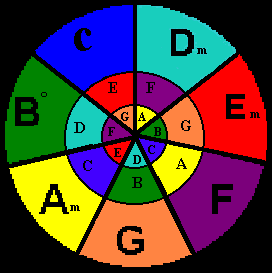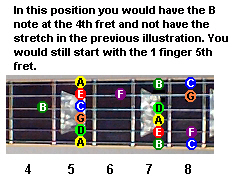In this lesson we will be covering the Aeolian mode.
 |
|
The Aeolian mode is the 6th mode in the Major key. In the key of C the Aeolian mode is played from A to A in the key of C Major. The Aeolian mode is my favorite mode. Look at the image below and this scale should look very familiar to you. Since the A Aeolian mode is a minor mode, you will find the A minor pentatonic scale too.
 |
|

Tablature for illustration above.
----------------------------------------------5-7-8--
--------------------------------------5-6-8----------
------------------------------5-7--------------------
--------------------5-7-9----------------------------
----------5-7-8--------------------------------------
-5-7-8-----------------------------------------------
 |
|
The A notes are highlighted above and the Aeolian mode is a minor mode in C Major. You would play from the A note Low E string 5th fret to the A note high E string 5th fret. Do you remember the Ionian mode that is played from C to C? That was the first Major mode we studied. Look at the image below and you will also see that mode in the illustration.
Tablature for illustration below..
--------------------------------------------5-7-8-
------------------------------------5-6-8---------
---------------------------4-5-7------------------
--------------------5-7---------------------------
----------5-7-8-----------------------------------
-5-7-8--------------------------------------------
 |
The image above shows the suggested fingering for this position. I played a progression using the chords C Am F and G and used this position to play most of the lead.
|
| The progression C Am F and G uses the chords as illustrated below. | |
| C Am F G /C Am F G / C Am F G / C Am F G/ | |
| F G/ F G/C Am F G /C Am F G / F G/ F G |
As illustrated before, the image below will show all the notes of the key of C Major. The Aeolian mode is played from A to A in the key of C major. Using the illustration below, figure out a few fingering patterns of your own. You can play this mode anywhere on the fretboard you like. But, the Aeolian mode starts with the A note. Also compare the positions above to all the notes below. See where they all fall in.

| Lay down a progression of Am, F and G and play the Aeolian mode. You can either write a song in the major or minor key. If you wanted to write a song in A minor, the notes would be: | |
| Am Bdim C D Em F and G. |
The notes are the same as the key of C major, but we have started with the A note for the A minor scale or key. You would base your tonic or first chord with the Am chord and use a minor progression something like Am F and G.
If we wrote our song in C major, C Dm Em F G Am B dim we would use the C chord as the tonic. We could use a progressions something like, C F and G.
If we wanted to write a progression for the E Phrygian mode, we would start with the Em chord. Something like, Em F and G. Use the Em as the tonic and this will determine the type of song we write.
The Aeolian mode is the natural minor to the key of C major. The Aeolian mode shares the same key signature as C major. There are no sharps or flats in the A Aeolian mode. If you were to play lead using this mode, you would play it over the Am chords and an Am progression. You would use this natural minor to construct the melodic and harmonic minors. This has been explained in the chapter titled, leading to modulation.
If you were playing a lead in the key of C Major using the C chord you could play lead using the Ionian mode or a major scale, such as C major pentatonic and start with the C chord. Or base your lead over the C progression. This mode and others have been explained in greater detail in the homework assignments.
| Practice this mode a few hundred times and I will see you in the last mode. The last mode we need to learn is the Locrian mode. The Locrian mode is a diminished mode. | |
| Look over some Am progressions. |
Good luck,
From the Jam Room









